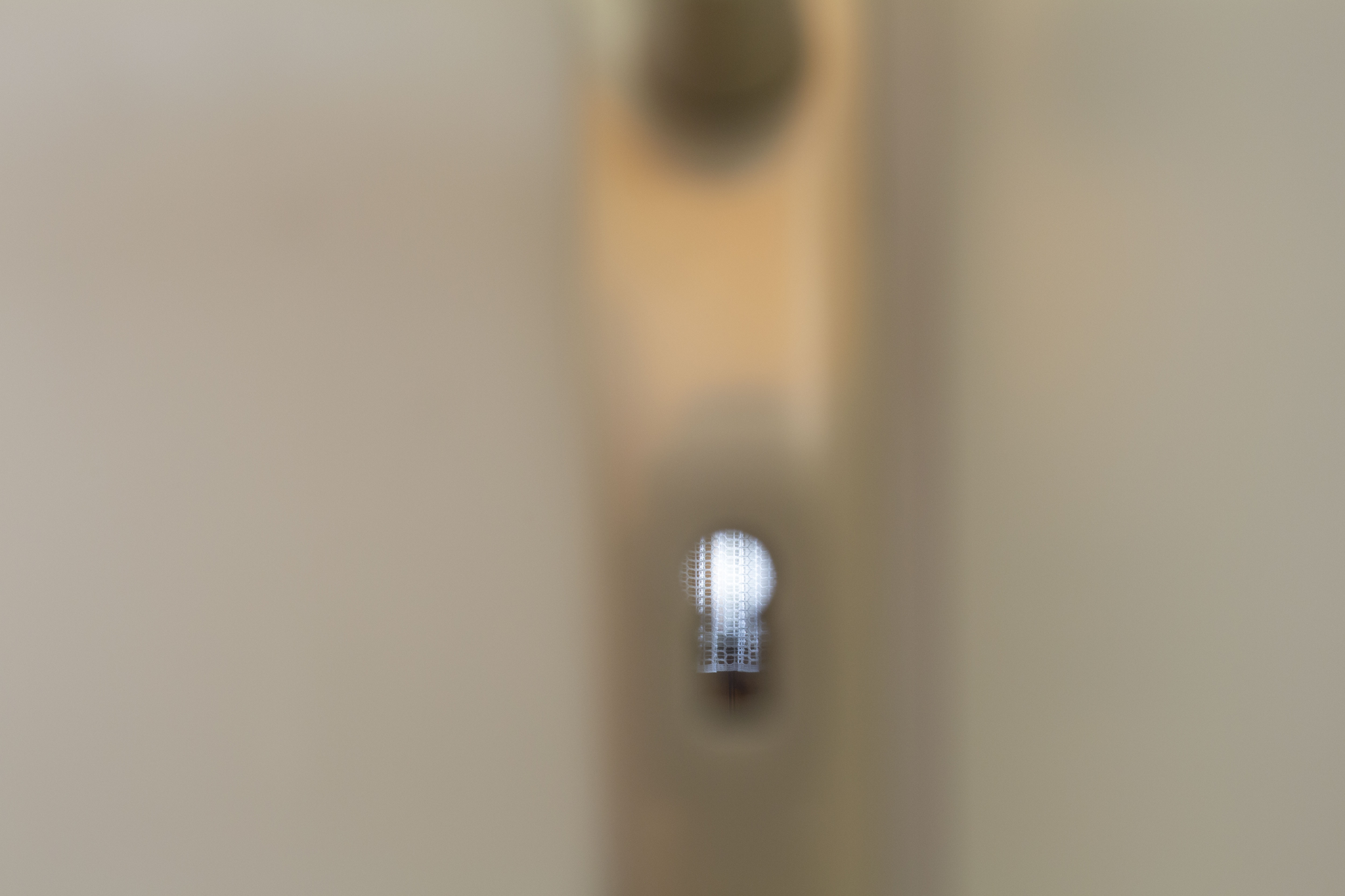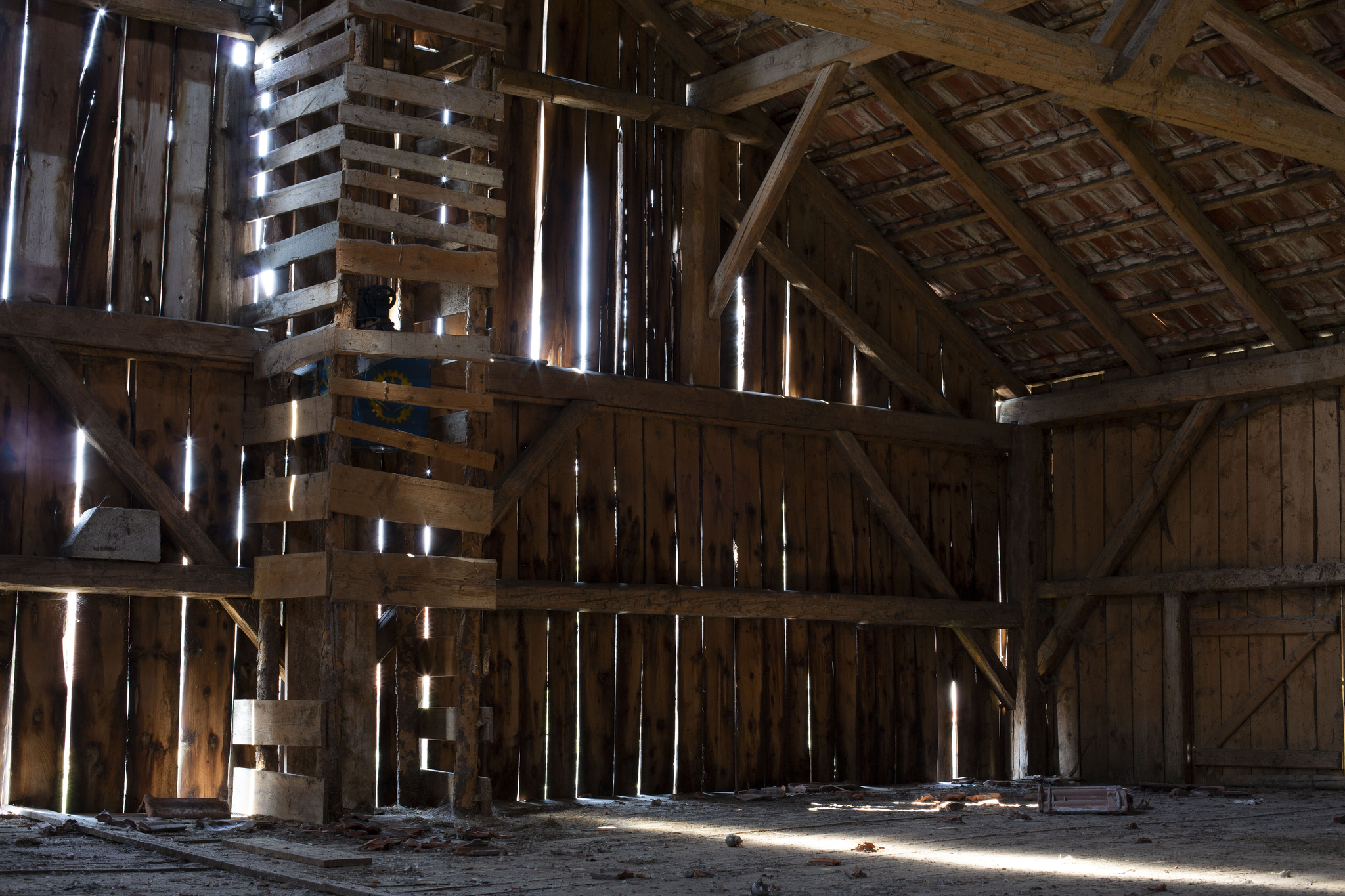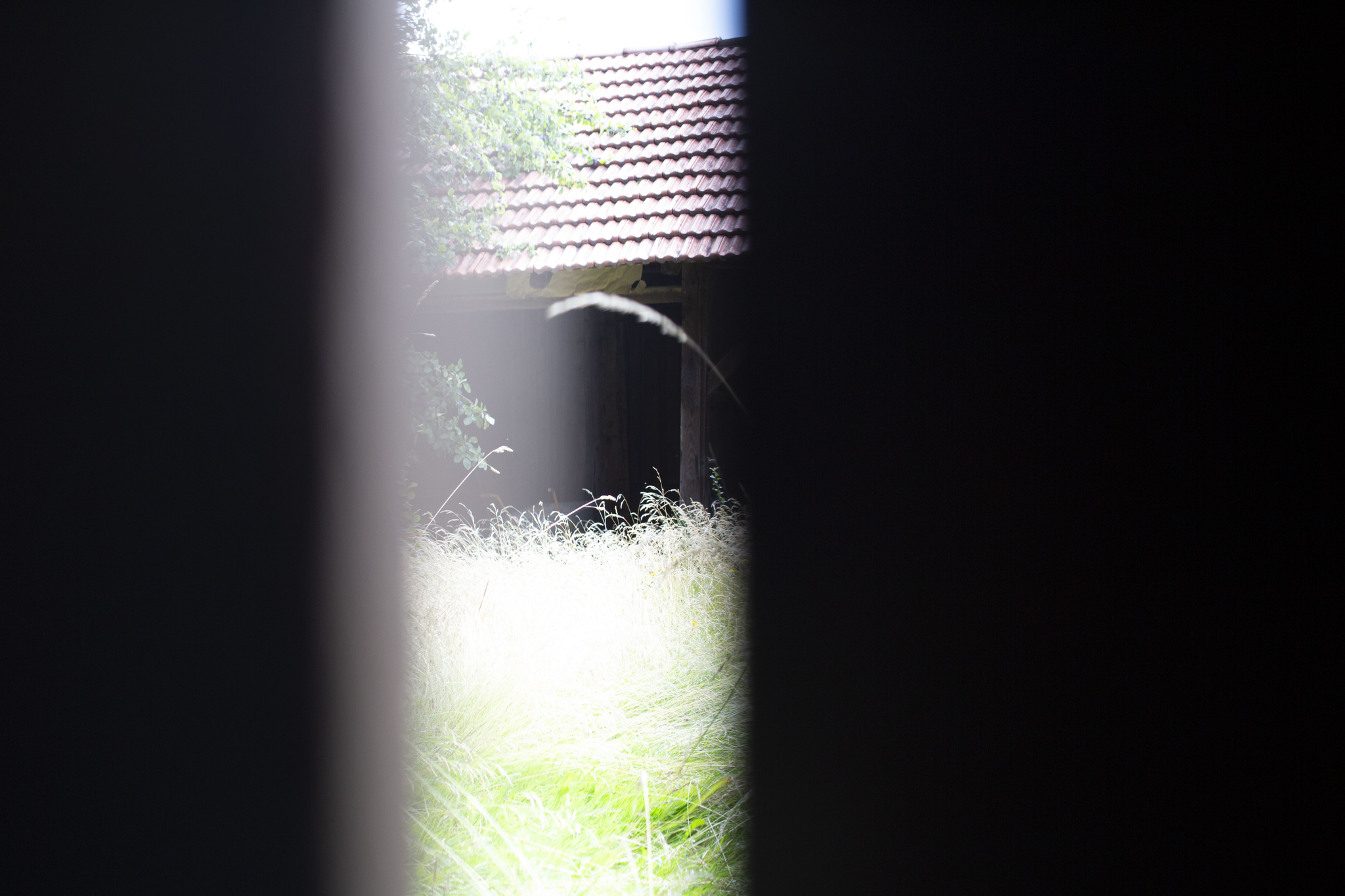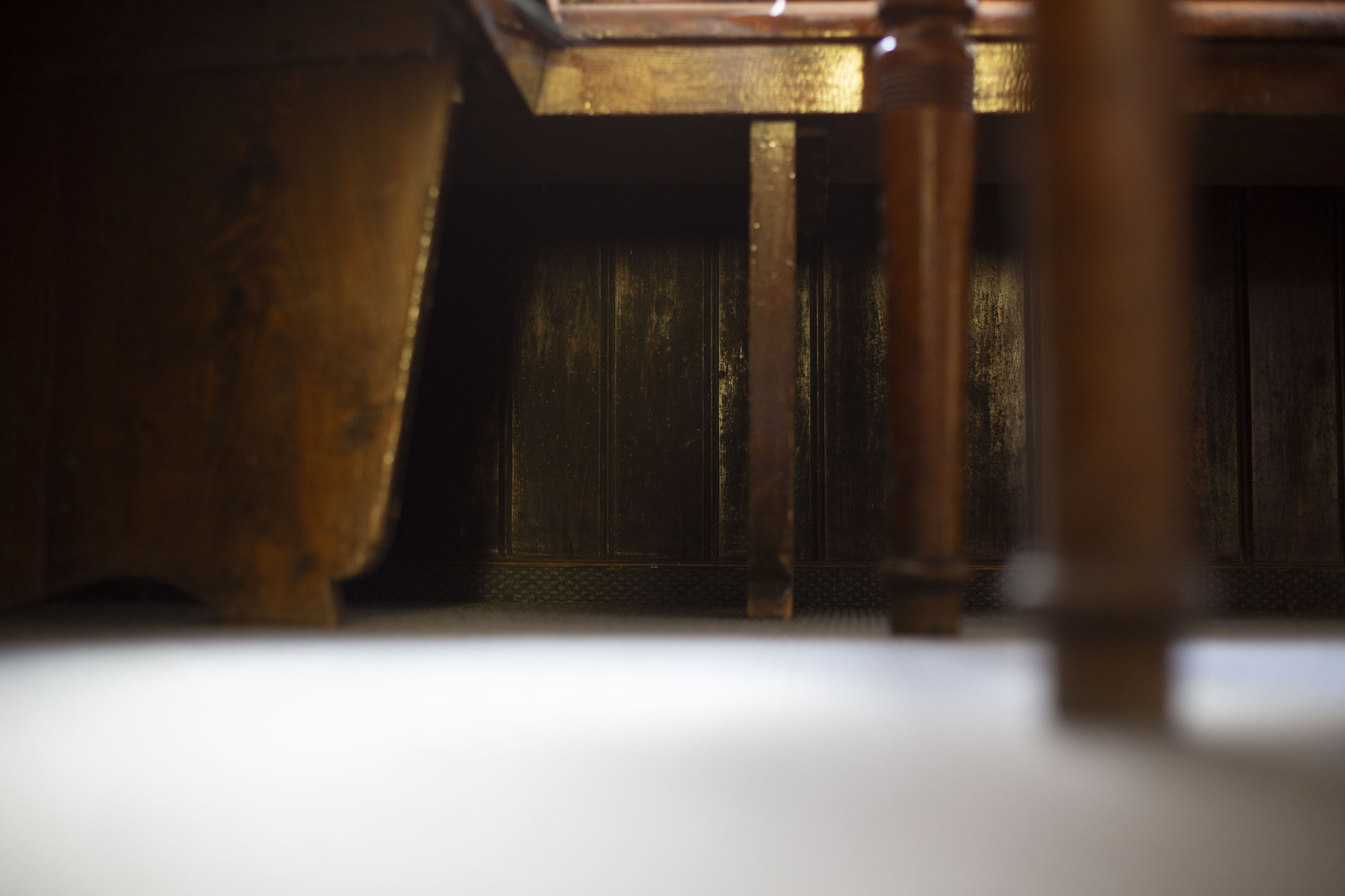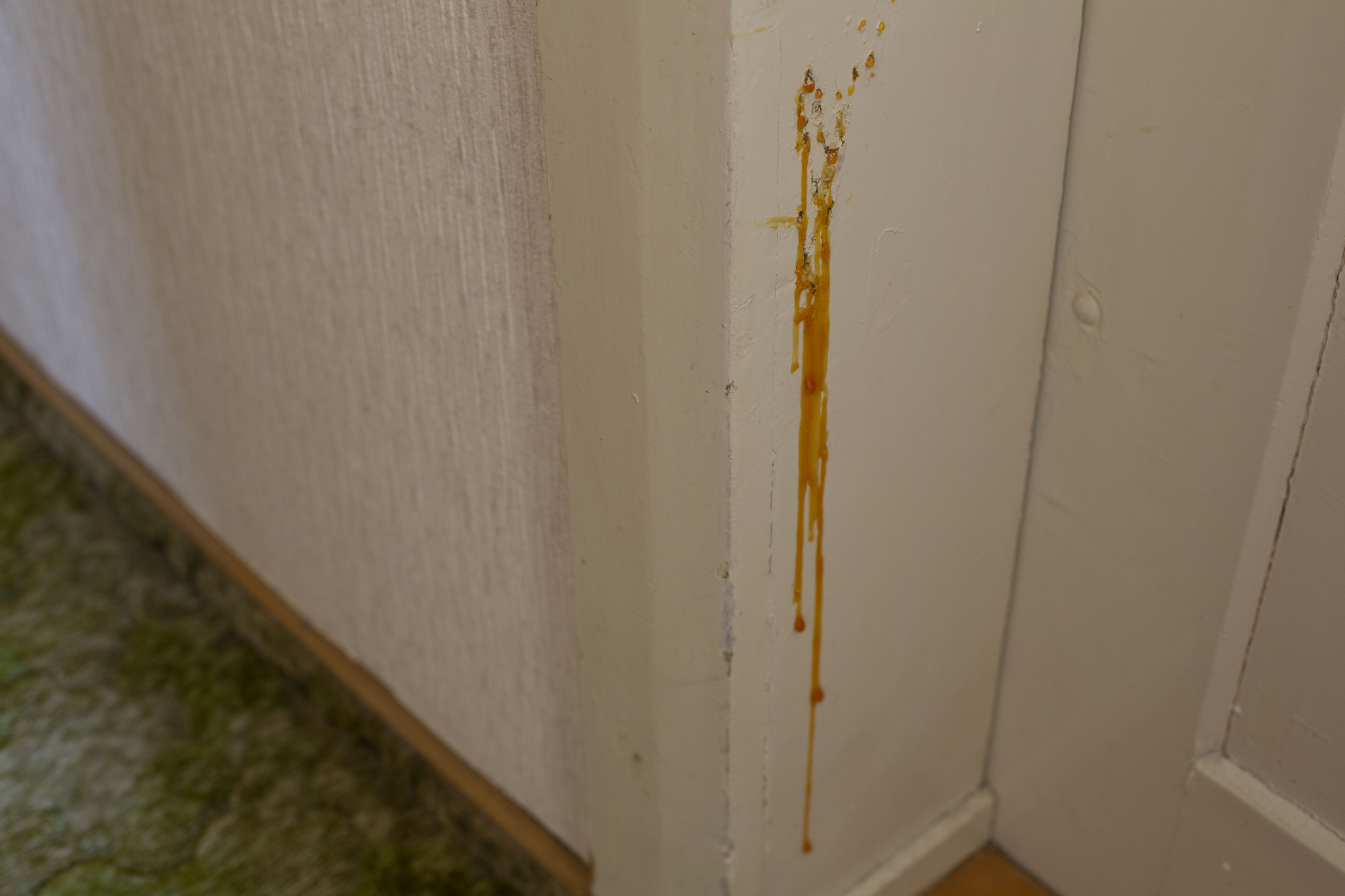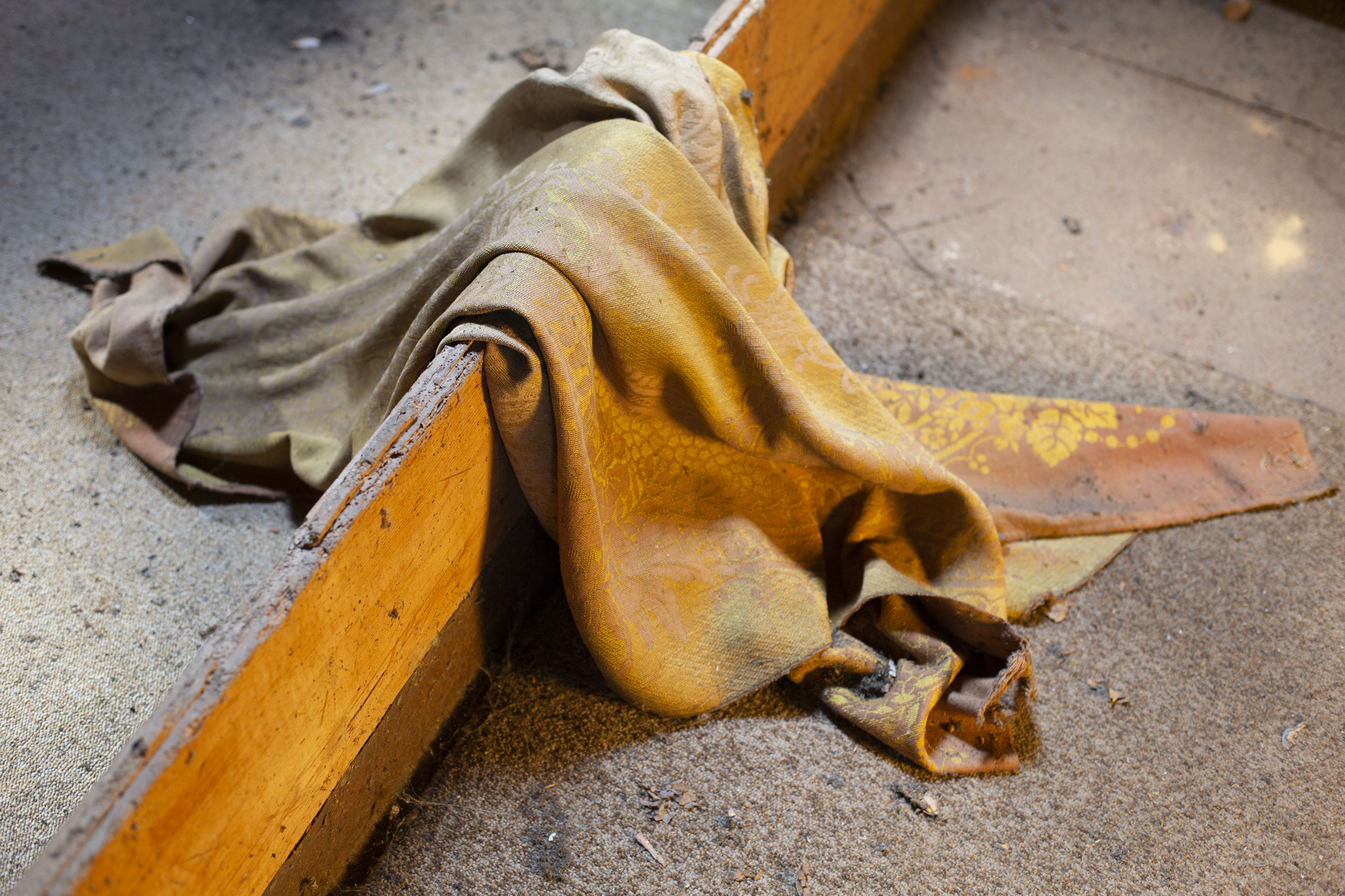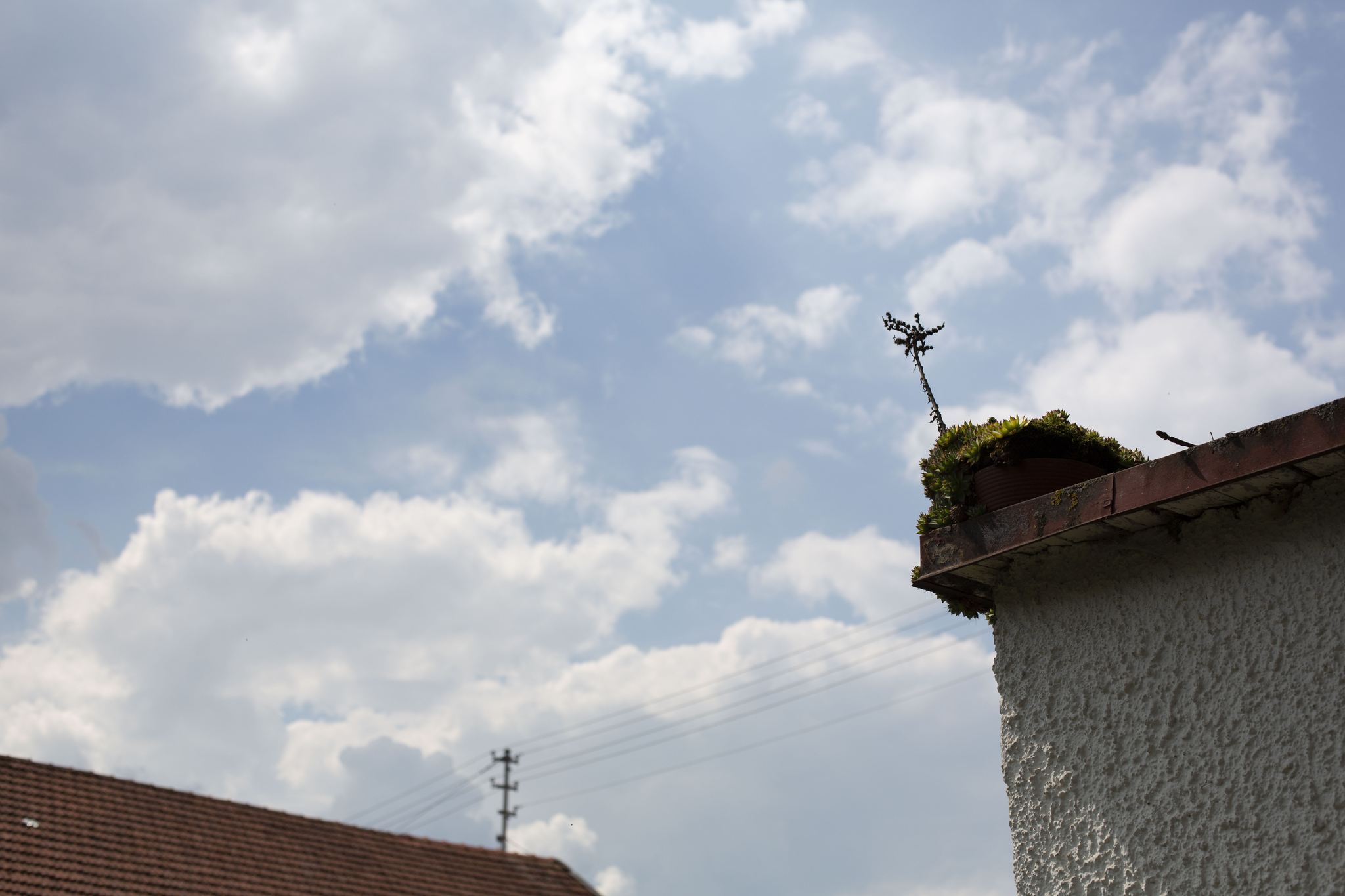Trying to translate L.’s neologism ‘versehnt‘ (adj.), I looked up the etymology of the probably related noun ‘Sehnsucht‘ and its English translation ‘desire‘. Sehnsucht comes from MHG ‘senen‘ – something like ‘painfully longing for’. Desire seems to come from the Latin phrase ‘de sidere’ – ‘await what the stars will bring’. It apparently doesn’t have much to do with the German word ‘Sehne’ for ‘sinew’, but versehnt sounds like a participle derived from a verbal form of Sehne, with the prefix ‘ver-’, like in ‘verbunden’ (bound) or ‘verloren’ (lost). Rebuilt in English, it would be something like ‘for-sinewed’. ‘Ich bin versehnt’ could be taken literal as: longing has strained criss-crossing sinews tearing and holding my chest together and apart.
I would like to invite you to a walk through my artistic research. I’m indwelling the field of the betwixt, the not-yet or the long-gone. Knowledge can assume unusual shapes. Questions can remain a longing. Findings can be ephemeral relations. The projected outcome is situated in the realm of the ungraspable, where ‘aesthetic thinking’ fosters agency:
In opposition to causal verification, to deduction or generalization, it behaves in a tangible, touching way towards its objects. It accords and considers, not to ambush these objects but to acknowledge and accept them, and thus to show their incomparability and vulnerability, and to show what remains unsatisfied by art. (Henke et al. 2020, p. 62)
With this following text, I built a path for us, tracing back my longing. Please do not expect me to tell you exactly what you will see on the way. Feel free to choose your gaze’s direction. It might be helpful to activate your mesopic vision; to consider what the words do show, if you make them shiver, if you see through or only remember them in your back. Convoy me to my findings’ habitat; let’s await what the stars will bring.
One has to be oneself all alone – I’ve always found that hard to accept. Researching how many people we are currently living on this planet, the internet spits out the number 7.918.159.736. Asking for a number of how many creatures we are in total, including all animals and plants, not even the internet dares to predicate a number. But obviously, “alone” does not exist.
Donna Haraway says: “The task is to make kin in lines of inventive connection as a practice of learning to live and die well with each other in a thick present” (Haraway 2016, p. 18).
I am doing art in order to relate – and to this mission statement, I could relate very well. Although trying to act accordingly, I became doubtful about how one can be ‚made kin’ to another. Would this not always be intrusive and presumptuous? Having been raised in a capitalistic, post-modern society, I have learned to praise “individual freedom” based on the autonomy of the subject for as long as I can remember as the most precious good I was given; a privilege that I must savour and never compromise. Trying to create relations while upholding my own as well as the others’ autonomy, my aim slowly shifted to finding already existing, ubiquitous entanglements shine, more and more understanding and cherishing my interdependency:
There are ‘ties that free’: the more the individual depends, the less free [she] is; the more the person depends, the more scope [she] has for action. When [she] seeks to spread [her] wings, the individual constantly comes up against [her] limits, moans and groans, overwhelmed by forlorn passions, there’s scarcely anything left for [her] to do but feel indignation and resentment; when the person stretches out, repopulates [herself], gets some distance, [she] scatters, in the strict sense of the word, [she] shares [herself], mixes, and step by step recovers powers to act that [she] never imagined. (Latour 2021, p. 88)
Maybe I should clarify: This is not a literature review about, i.e. Donna Haraway and Bruno Latour. But I find a longing akin to mine glimmering through their words; they help to trace and phrase what it makes me do: I try to be present – because if we all are, the present becomes “thick“ (cf. Haraway 2016, p.18); I try to “stretch out“ (cf. Latour 2021, p. 88) – to look, listen, sense considerately, and offer some fringes to hold on. I actively, attentively wait, sometimes longer than the moment we share. I let myself be carried along. I try to adopt or at least imagine other perspectives, share choices, find language to express experience. I try to co-create – whether ‘you’ are very young, an old soul, or maybe not even human. I use the term co-creation instead of collaboration or cooperation because it emphasises the co-active making or tending of common world-bits, of meaning and therewith of relations. I presume one always cares for what one is related to; thus, co-creation supports careful handling of the world and all its critters.
Relationship among all things appears to be complex and reciprocal—always at least two-way, back and forth. It seems that nothing is single in this universe, and nothing goes one way. In this view, we humans appear as particularly lively, intense, aware nodes of relation in an infinite network of connections, simple or complicated, direct or hidden, strong or delicate, temporary or very long-lasting. A web of connections, infinite but locally fragile, with and among everything—all beings—including what we generally class as things, objects. […] Poetry is the human language that can try to say what a tree or a rock or a river is, that is, to speak humanly for it, in both senses of the word “for.” A poem can do so by relating the quality of an individual human relationship to a thing, a rock or river or tree, or simply by describing the thing as truthfully as possible.
Science describes accurately from outside; poetry describes accurately from inside. Science explicates; poetry implicates. Both celebrate what they describe. We need the languages of both science and poetry to save us from merely stockpiling endless ‘information’ that fails to inform our ignorance or our irresponsibility. (Le Guin 2017, p. 15f)
If science helps to understand what things are, poetry helps to understand how to relate to them. The insight one can gain through artistic or poetic research is always intersubjective. Thus, if a poem is “relating the quality of an individual human relationship to a thing, a rock or river or tree“ (Le Guin 2017, p. 16), I would suggest that poetry always is co-creation.
“Poetry” in that sense, can imply all sorts of means, tools and media – it is not bound to words. A melody, an image, a conversation, a moment can be poetic as well. Therefore, the term “poiesis” (in the simplified sense of “making something” as opposed to “doing something”) might seem more appropriate for my purposes. But something “poietic”, creative and formative, is not necessarily poetic. A poem, whatever it consists of, actively relates different actors to each other. It becomes an actor itself, continuously transforming and being transformed. Poetry makes humankind a little bit more like the “Oankali” in Octavia Butler’s science fiction trilogy “Xenogenesis”: The Oankali dispose of sensory tentacles, through which they can connect to each other as well as to any other living being and can communicate and perceive directly without the need of signs or translations. They just become one nervous system sharing pleasure and pain. (cf. e.g. Butler 1987) As long as we don’t develop such organs, we need poetry1 to be able to understand all our complex interdependencies.
But coping with such entanglement is quite challenging:
No, really, he [the hero in a novel] can only ease his anxieties by resting his eyes on the moon: for its circling, for its phases, at least, he in no way feels responsible; it’s the last spectacle he has left. If its brightness moves you (tu) so much, that’s because, well, you know you’re innocent of its movement. As you once were when you looked at the fields, lakes, trees, rivers and mountains, the scenery, without giving a thought to the effect your every move might have, however slight. (Latour 2021, p. 12)
It is a paradox: Realising how dependent we are and how responsible we are for everything that goes wrong on this planet makes being alone even harder to take. Losing our (illusive) independence does precisely not mean getting rid of inconvenient responsibilities:
And yet, what an evasion it would be to abandon anthropocentrism at the very moment when modernised humans, in their number, in their injustices, in their well and truly universal expansion, are starting to weigh up the fate of other lifeforms – to the point of being seen, in certain calculations, as the agents of a sixth extinction. (Latour 2021, p. 106 f)
We must remain capable of acting and consciously responsible instead of feeling tangled up in self-pity. But I think experts can help us to work out new ways to relate to the world, and all there is day by day: Children are used to be depending, fearlessly loving and fragile, constantly on the heels of terms and consciousness, yet courageous and almighty. Adults know they are not almighty and have never been, so they hide their fragility, focus on the unambiguous, try to show endurance and resilience.
Obviously, it is beneficial if adults secure daily survival through being adult and caring for the fragile ones. And they can do some things that children can’t do yet. But – and this is the hypothesis my work is based on – it can be agency-expanding to understand children not only as the ones to be taught, educated, and tamed – but as co-creators of present realities. Answering Donna Haraway’s prompt “Make kin, not babies!“, I’d say: “More ooze, less order!”2
Ten years ago, I spent one year in Iceland. After six rather dark and lonesome months, I moved into an Artist Residency in Reykjavik. The days became longer, and I was blessed with some very particular encounters. Among those were Abdolreeza Aminlari and Nico Economidis, an artist couple from the U.S. We spent most of the four weeks together. Walking along the seaside through ever-changing snow and sun, I photographed the two of them countless times while Abdi was taking pictures of Nico. It hurt incredibly when they left. I had been sipping some of their overflowing gracious love, but they took it all back to New York and left me alone again in the northern cold. To milden my heartache, I made two copies of a booklet with the pictures I had taken, titled so good to see you. I sent one to New York, and kept the other one. It was a gift to them as well as to myself; and a tribute to photography performing a tender gaze.
Following this, I produced a rather extensive series of such two-copied little books. All of them “for” (that is “through” and “to”) other artists, for short-term encounters, for places, for a dead whale, for other versions of myself. They all were materialised relations, co-creations objecting to time, space, and loneliness.
I have always earned my living by doing animated film- and sound workshops and working in art education as a museum guide.
This is part of my artistic practice, but I also perform a service. People pay to be entertained, educated, occupied. Many of my amazingly talented and inspirational colleagues are seen as and understand themselves as student-workers (no matter what age) – actually pursuing a different career.
That got me frustrated. I am bored being asked, after having held a workshop and leaving a group of people, including myself, glowing, inspired, thrilled: So – what do you actually do? Or: What is your own artistic practice? I decided to search for or create spaces where workshop situations and collaborations with kids and artists would realise the potential I presumed was left unseized. I aimed to stage the sometimes mesmerising collective artistic emanations; and to understand and grasp my role in the process more and more – not least in order to make its quality be seen and appreciated.
The Austrian school system is not particularly known for being an institutionalised cradle of artistic freedom, but I decided to occupy as much space as possible and use infrastructure that often lay fallow. The idea was to produce video experiments with school classes that would be radical co-creations, thoroughly woven and coherent but without a script or given topic. Movies like birch tree forests with one big, invisible root system of a collective process, giving as much agency to each individual as possible.
I realised eight such projects. In each case, the starting point was a collectively produced sound piece, afterwards becoming the film’s audio. Every kid would add at least some rustle or knock or bumble or buzz. The sound-artist Werner Möbius and the musician Oliver Stotz helped to make these sound-pieces enthralling and therewith abiding the rest of the process. The visual part then offered almost unlimited possibilities to get involved – which is inherent in the medium of video: Everything visual can become part of the collective piece; even the void, be it resulting from individual opposition and withdrawal or consciously applied as black gaps on the video timeline. Rooted in the sound and supported by me and sometimes other artists involved, the kids developed pictures, performances, choreographies, texts, stage- and light designs, costumes, scouted locations and so on and so forth. All fell into place, as the editing was defined by the previously produced soundtrack.
The projects went incredibly well. The films grew organically and became traces of particular constellations of people, space and time. Everybody involved was amazed seeing the videos on the big cinema screen in the end.
But the birch trees grew so well that I got lost in the woods: More than 125 students, around ten other artists, even more teachers – but I felt lonesome. The videos became quite eerie, featuring often violent pictures the adolescents found foreign and uncanny, although they had made them up themselves. Was it good to stage these films publicly? Would anybody not involved recognise the traces of relation that I saw? Would even the kids perceive the films as glowing collective emanation? Or rather as something merely unsettling? Was it ok to leave them alone with what they/we had done after the end of the project? By being willing to stage and appraise the kids, wasn’t I hiding behind them, pushing them on stage while patronising them? Whatever you do will eventually circle back to yourself – thus choosing to act means accepting to be vulnerable in a certain way. By trying to “give agency“, didn’t I coerce the adolescents to act in systems unfamiliar and conceivably upsetting to them?
If someone gave me money, time, and space, I would (still) love to continue doing and developing similar projects forever because it was so inspiring and exciting to me, and I hope for most of the participants involved. But things did not clarify, rather revealed their twisted and twirled complexity.
I had planned to build my PhD endeavour on those video projects, but I realised that just going on doing video projects with school classes wouldn’t help to proceed. I decided to take a step back and sort things out. The little books I had made in Iceland had proven helpful to find hold through relating to moments, encounters, glimpses of insight. So, I tried to use a similar procedure, sleuthing red lines to find my way through my dizzying woods: Following resonating moments or terms or references, I produced such booklets again, each dedicated to singular threads of thought, not yet arranged or ranked; incomplete.
On my desktop, I organise files (texts, sounds, pictures, videos) of yet nondirectional interest in folders I call ‘Voliere’ – the French/German word for ‘aviary’. I imagine them flying around in there, and each time I pry inside, another snippet will flit by and whisper something new.
Therefrom, presenting my new series of booklets in our group of PhD candidates, I titled this loose collection Welcome to my aviary. I was hoping to enable the others to peer through some window into my fluttering space of thoughts, grasp some thread and relate. To enable this, I dedicated one book to each of my colleagues, taking up some image or idea I had grasped from their presentations. I thought of them as little gifts that would give an idea of how I try to relate. But unasked gifts aren’t always happily received.
Within my short presentation, I had to pull all my yet unsorted red lines together, creating a rather unresolvable knot. And my colleagues found themselves more or less successfully knotted within, caged in my aviary. One of them said – at least – she was touched by my courage to show where I found myself trapped. That was not exactly what I had imagined.
I was puzzled. I liked sitting in my aviary. I liked what I did with the kids, and I knew I did a good job, but the how, the what, and the why were so hard to explain and seemed hardly comprehensible.
For quite a while, I had been looking for references in the work of nature writers and scientists, for example, in the work of Jean Henri Fabre. Fabre spent most of his 19th-century-life crawling through his rocky fallow land, following beetles, bees, bugs and everything creeping and crawling around him – instead of spiking them on needles. His extensive Souvenirs Entomologiques became very influential for the development of behavioural science, although during his lifetime, Fabre was struggling with the reproach of being a writer rather than a scientist (cf. Auer 1995, p. 99f). Instead of taxonomising, he anthropomorphised the insects; not to abuse them as metaphors but to be able to relate to them as a condition to perception and understanding.
Despite my admiration for Fabre – explaining what my work with children has to do with his research could seem a bit farfetched. But:
Aesthetic practices map out non-scientific epistemologies by drawing their form of knowledge not from syntheses but rather from the sensuous relations of non-predicative conjunctions in which their insights merge and coincide. […] Compositions are combinations, montages, or “splices” without specific rules, not focused on identities but instead co-presenting the incompatibility of the elements, their nonsense. (Henke et al. 2020, p. 39)
Jointing Fabre’s commonality with the insects and my take on co-creation, I realise that Fabre, to me, is an exemplary artistic researcher of co-creation (“avant la lettre”, of course). He sincerely tried to picture being the other – while always being conscious of necessarily failing, as in his case, the Other was not even human. Still, he invested inconceivable amounts of time, close attention, and effort to converge to other perspectives (even in a bodily manner by crawling with the bugs and beetles he observed) and of imagination, working unremittingly on conveying his insights through his writing.
I feel very drawn to his way of working, with his effort to go where the beetles are instead of collecting them in his drawer, waiting hours for some critter’s decision to show up and interact. But working as a teacher or educator, just waiting for kids to show up and interact is a bit difficult. However open and dialogical my concept is, I remain responsible for the bigger scope, for clarifying what can be expected and, at least to some extent, for making things work out. The children’s personal development, their learning, and their agency are what I feel obliged to aim for, regardless of who they are. My personal learnings and insights, if relevant at all, are always related to this prior aim of supporting the ones entrusted to my care.
I must admit, though, that I am constantly looking for moments when my young partners nor I need to fulfil such a given role or task; when I don’t need to define any goal and we can roam side by side through unforeseen places, enabling insights none of us could gain alone.
Artistic research, therefore, appeared as a luxurious space: “The potential of artistic research consists in asserting undisciplinarity, allowing for uncertainty, integrating negativity, and searching for clarity” (Henke et al. 2020, p. 18).
But artistic research as fundamental research is risky: You cannot know if all endeavours will yield something useful, insightful, enchanting, or maybe even something disorienting, shattering and dangerous.
Of course, I do not want to lure children or any other collaborator into possibly harmful situations. Therefore, I try to create something like a mobile safe space, which as a professional artist, I can carry, while together advancing to unpredictable grounds. The farther we get, the more we move into unknown fields and the more power it needs to hold such a trustful space lively and open. I anticipate what could possibly happen next, afterwards and in between and offer protection or guidance in time, if necessary, in a well-dosed manner, without demolishing what has already been achieved.
The most vigorous resource to endure such tension is unconditioned and undetermined relatedness, love. Such bias should be avoided under most circumstances in other sciences and possibly endangers equal treatment in educational contexts. But it constitutes my artistic research superpower.
I find such an approach resonating in Olga Tokarczuk’s acceptance speech for the Nobel prize in literature:
[…] Tenderness personalizes everything to which it relates, making it possible to give it a voice, to give it the space and the time to come into existence, and to be expressed. It is thanks to tenderness that the teapot starts to talk. Tenderness is spontaneous and disinterested; it goes far beyond empathetic fellow feeling. Instead it is the conscious, though perhaps slightly melancholy, common sharing of fate. Tenderness is deep emotional concern about another being, its fragility, its unique nature, and its lack of immunity to suffering and the effects of time. […] It appears wherever we take a close and careful look at another being, at something that is not our ‘self’. (Tokarczuk 2018, p. 392)
I find it helpful to talk to myself as a child when trying to grasp and make understandable what I am seeking in co-creation with children. I was not a particularly lonesome child. I’ve had a loving mother, an absent father, caring grandparents, my dear sister, some peers and many trees around.
But I always longed for an adult friend of a different kind. I got furious when I realised that some adults were only pretending to be interested in my endeavours. I was longing for some sort of Peter Pan, joining my childhood adventures, taking them as seriously as I did, but being capable of doing things a child cannot do. Helping to realise fantastic plans, building stuff, or just assisting with endurance if I lost track.
When my first nephew L. was born eight years ago, I decided to try the best I could to be such a friend to him. But I did not expect what a close friend and artistic companion he would become to me.
When he was three, he sent this poem to me:
Ich wünsche Dir schöne Geschenke im Winter.
/ I wish you beautiful gifts in winter.
Und schöne Schmetterlinge und Hasen in tot, die man anlangen kann.
/ And beautiful butterflies and rabbits in dead, which one can touch.
Sonst die ganze Welt in ganz ganz schön blau.
/ Else all the world in all all-beautiful blue.
I was moved to tears. Since then, we have written a book about a sea-sick pirate, a knight who specialised in spinning fabric for tunics with a curly-haired horse, a lonesome pink dragon, a wolf that longs to be a dragon and miniature omniscient mole-dwarfs digging themselves from story to story. All of them fragile hero*ines, overcoming what Ursula K. Le Guin named the “killer story” (Le Guin 1986/1996, p. 152) and finding affirmation of different kinds.
We made audio pieces about the jungle-sea and its dwellers, with oceans walking over shady grounds and crabs becoming secret letters when they die; about wobbering, spinning, hovering, floating creatures and critters from other galaxies; bacteria as big as a blue whale, monsters hollowing out the sun, firedogs dying paw on paw; there were trees full of honey and water grounds gloopy like ice; dancing houses with secret mechanics, always close but never touching and a moon made of stardust.
We made animated films that took us to outer space in rockets made of wizened leaves. We’ve been turning L.’s room into the sparkling kingdom of a jellyfish. We read The sea around us by Rachel Carson, examined the sun’s surface, recorded mud puddle music and spoke to a fish. Dear L., you gave treasures to me no kingdom could pay, and I tried to find things as precious to give them back to you.
Implying our relation, what we did together, the gifts I made for L. and even more what he gave to me, to my artistic research, to my PhD endeavour, at first seemed to yield clarification: It was just the two of us – not 125 foreign kids, no institution intercalated, no labour contract, no debts and duties.
But I soon realised my dilemmas followed wherever I went: L. and I were just two, but what we did was never clearly framed as a workshop, as something partly public. It had no defined beginning and will – hopefully – have no end. It is always intimate, private, and surprising. Plus, I am not only his aunt, his co-artist, and his friend, but also the sister of his mother, the daughter of his grandmother, the aunt of his younger brother, the sister-in-law of his father and so on and so forth. With all those people and, of course, many more, we both have relations that couldn’t be more differing.
If I try to reflect on what L. and I do, the relations to all those people play immense roles. How did I communicate with and involve my sister, making it possible she would trustfully let her young one join me, going to places that she wouldn’t? How do I not lose sight of my dear other nephew, whom I want to be a good aunt for just as well? How do I, often inexplicitly and from afar, anticipate the familiar situation L. finds himself in? Is it helpful for the whole family if L. is occupied for a while or is it rather stressful to set up a skype call for us?
These are rather truisms, but I realised that if I wanted to go deeper reflecting on what I do with L., what we do together, I find myself lost again in birch wood forests of relations even vaster than before. And: There is hardly any thought worse than the apprehension that L. could one day resent me for having published or “used” what we’ve had together.
Thus firstly, I am working on finding artistic forms with L. that we both agree on and want to share. But it is rather absurd to ask L. for such decisions, so in the end, deciding on what to publish in what way is part of my risk and responsibility. I have to approach imagining L.’s present and future perspectives as well as I can.
Secondly, as a researcher, I am trying to find language and form to make my/our birch tree forest accessible, offering walkable paths, observation decks, ways in and ways out – keeping some areas restricted for privacy reasons or for the danger of getting irredeemably lost.
Sitting in my woods again, I tend to still feel lonesome. I am L.’s adult friend, but adult friends joining my adventures are still rare. There is hardly anyone stumbling over the same roots and trunks, having the same boles blocking sight, hardly anyone limping with me. Relating being my foremost aim, I’m struggling with the fact that seldomly within academic contexts, someone seems to be willing to relate. Or is it me, in fact, who can’t relate?
When getting lost, lifting one’s gaze can help. The stars are far away – and pulling them too close would even be counterproductive because only in constellation with others can they offer orientation.
At ZOOM Children’s Museum in Vienna, where I have been working for more than 12 years, dozens of inspiring artists have worked with children, mostly throughout their professional biographies. Unimaginable, they wouldn’t know at least parts of my woods.
Hence, I now started a book project. My aim is to provide a stage for the amazing artists who have shaped the Children’s Museum. I did interviews with 12 colleagues so far, but we did not primarily speak about the museum. To start with, I asked them: What would you do if you would get to spend time with yourself as a child for one afternoon? Where would you take yourself? What would you ask or tell or show yourself?
In all the conversations, we got to some sort of initial art moment in childhood that, in diverse manners, related to what my colleagues pursued as professionals and what they thought and sought. For example, one would build spaces to hide and protect his peers, another collaborates with the sea by drawing in the sand, another was thrilled by a painting of flowers that flies mistook for real, yet another would build little bombs in order to create holes.
I am fascinated by how a person becomes visible through its individual and gradual creation of thoughts while speaking (thinking of “Über die allmähliche Verfertigung der Gedanken beim Reden”, the famous essay by Heinrich von Kleist). Thus, I would like to just publish those conversations in full length. But of course, no one would ever read, and my colleagues wouldn’t be very pleased either.
Instead, I need to find a narrating voice, retelling those stories, that will grasp the particular voices of my colleagues and open up this sparkling spectrum of kinship between art making and relating to the world as a child or with a child. As I am also rather an amateur in writing, I might do what amateurs (people who love) can do best: I want to write letters to my colleagues, mirroring the spaces our talks opened up for me.
I am convinced that the knowledge gained in artistic research cannot be named and listed. It lies in the process, its fluid methodologies, and in the making that can obtain and provide agency. Its strength is rather showing than telling. But if I tell, maybe some will look, so I can show, and what is seen might be handled with care. So here is my doubtful list of certain learnings:
Publishing a text is like writing a letter into the blue, leaving me waiting for your answer. Unfortunately, I don’t even know your mailing address, but I hope my words will still be well received.
reposition is an anonymously peer-reviewed publication – so to my great delight, I have already been provided with two densely filled pages of review text, one in German, the other in English. The idea of a peer review is to consider the reviewer’s critique to improve the text before publishing. I am very thankful for the considerate feedback and would like to answer those letters. But I am not allowed to get in touch.
Therefore, I couldn’t resist starting imagining the persons behind the text. Please excuse my wild attributions in the following – any resemblance to persons living or dead is purely coincidental:
In my mind, the German reviewer is a woman working as a philosopher in an academic context. She is a very considerate and empathetic person, with a cabin on some ocean’s shore, who, in between reading and writing, likes going for long walks, incorporating the ever-changing colour of the sky into her thinking. Somehow, I imagine she could have written those lines by Rachel Carson:
One stormy autumn night when my nephew Roger was about twenty months old I wrapped him in a blanket and carried him down to the beach in the rainy darkness. Out there, just at the edge of where-we-couldn’t-see, big waves were thundering in, dimly seen white shapes that boomed and shouted and threw great handfuls of froth at us. Together we laughed for pure joy – he a baby meeting for the first time the wild tumult Oceanus, I with salt of half a lifetime of sea love in me. But I think we felt the same spine-tingling response to the vast, roaring ocean and the wild night around us. (Carson 2017, p. 15)
Obviously, I feel very kin to her and also well received when she writes:
Bearing on life and revealing of realities through ‘making art’ positions the world of aesthetics at the right point: Inside of the art-creating human entity, within social encounter, intersubjective spaces… instead of within art ‘itself’. A beautiful project. [thank you!, note VMF]. The project’s premise lies in the tension between experiencing contingency (‘One has to be oneself all alone’) and an articulatory interpretation of the animal social, which is to be resolved through active making kin (Haraway). The focus lies on infantine competences, that refer in a fully positive way to the Anthropinon, namely the human capability to actively create one’s relation to reality – in the scope of the presented project, the author is looking for means and ways to uncover and maieuticly foster such abilities. (Excerpt from review, translation, E. & O.E.)
I would also like to thank her for suggesting the reference to Nietzsches ‘Holy Yea!’ as an existentialist-anthropological grounding for my appraisal of working with children:
Innocence is the child, and forgetfulness, a new beginning, a game, a self-rolling wheel, a first movement, a holy Yea. Aye, for the game of creating, my brethren, there is needed a holy Yea unto life: ITS OWN will, willeth now the spirit; HIS OWN world winneth the world’s outcast. (Nietzsche 1999/1883-1885)
I am no philosopher, and for the time being, I can just use this as a beautiful poetic reference. But going further, I think I would tackle “Innocence is the child, and forgetfulness“ (ibid.). In my experience, adults still tend to deny that children’s souls can be abyssal – and to abuse them as a screen for their lost and romanticised insouciance. I try not to do so.
As she suggested, I also peeked into Helmuth Plessner’s Levels of Organic Life and his Law of Mediated Immediacy. I totally agree that I am struggling with shifting from the individual observation to the general and with the question of how my insights can and why they should be made accessible for anyone out of reach. Akin to this, the question is whether any structured way of finding new young co-creators exists, not only relying on serendipity and young wise souls appearing in my life. Plessner’s thinking is therefore added to my shelf of yet unread but already inspiring books.
The English reviewer feels a bit more distant. I imagine him to be a city dweller, either baldheaded or, if available, wearing a curly and well-trimmed crown of hair. He is very established and cross-linked within academia. He has an artistic background but is very sceptical if the term ‘artistic’ is used as an excuse for not meeting scientific criteria. He is very good at writing proposals.
Summarising my approach, he endowed me with the term ‘methodical vulnerability/uncertainty’. This sounds good, although ‘vulnerability’ by itself is not what I aspire to. But I am convinced that the admittance of being fallible, doubting and courageously in love is the necessary condition for methodically finding ways to relate.
I must admit, meanwhile, I have learned that the excerpts I received had been written by three reviewers – two male, one female. But I have become so fond of my imaginary responders that I decided to keep hold of them for the time being.
Right before giving this text out of hand, I have been talking it all through with L.; fortunately, he is no imaginary nephew but a very focused and thoughtful reviewer as well. He said this is now ready to be published.
Thank you for reading, and all the best to you!
Verena
Martin Auer, Ich aber erforsche das Leben. Die Lebensgeschichte des Jean-Henri Fabre, Weinheim: Beltz 1995.
Octavia Butler, Dawn. A Lilith’s Brood Novel, New York: Warner 1987.
Rachel Carson, The Sense of Wonder: A Celebration of Nature for Parents and Children, Reprint Edition, New York City: HarperCollins 2017.
Bruno Latour, After Lockdown: A Metamorphosis. Cambridge: Polity 2021.
Ursula K. Le Guin, “The Carrier Bag Theory of Fiction” in: The Ecocriticism Reader. Landmarks in Literary Ecology, Athens/Georgia: University of Georgia 1996, pp. 149-154.
Ursula K. Le Guin, “Deep in Admiration“ in: Anna Lowenhaupt Tsing et al. (eds), Arts of Living on a Damaged Planet: Ghosts and Monsters of the Anthropocene. Minneapolis: University of Minnesota 2017, pp. 15-21.
Donna J. Haraway, Staying with the Trouble. Making Kin in the Chthulucene, Durham and London: Duke University 2016.
Silvia Henke et al., Manifesto of Artistic Research. A Defense Against Ist Advocates, Zürich: Diaphanes 2020.
Friedrich Nietzsche, Thus Spoke Zarathustra. A Book for All and None, Translated by Thomas Common, Projekt Gutenberg 1999 URL: https://www.gutenberg.org/files/1998/1998-h/1998-h.htm#link2H_4_0006, accessed on August 10 2022.
Olga Tokarczuk, “The Tender Narrator. Nobel Lecture, 7 December 2019”, in: The Nobel Prizes 2018, Eva Windrup/Karl Grandin (eds.), The Nobel Foundation 2018, pp. 377-398.
